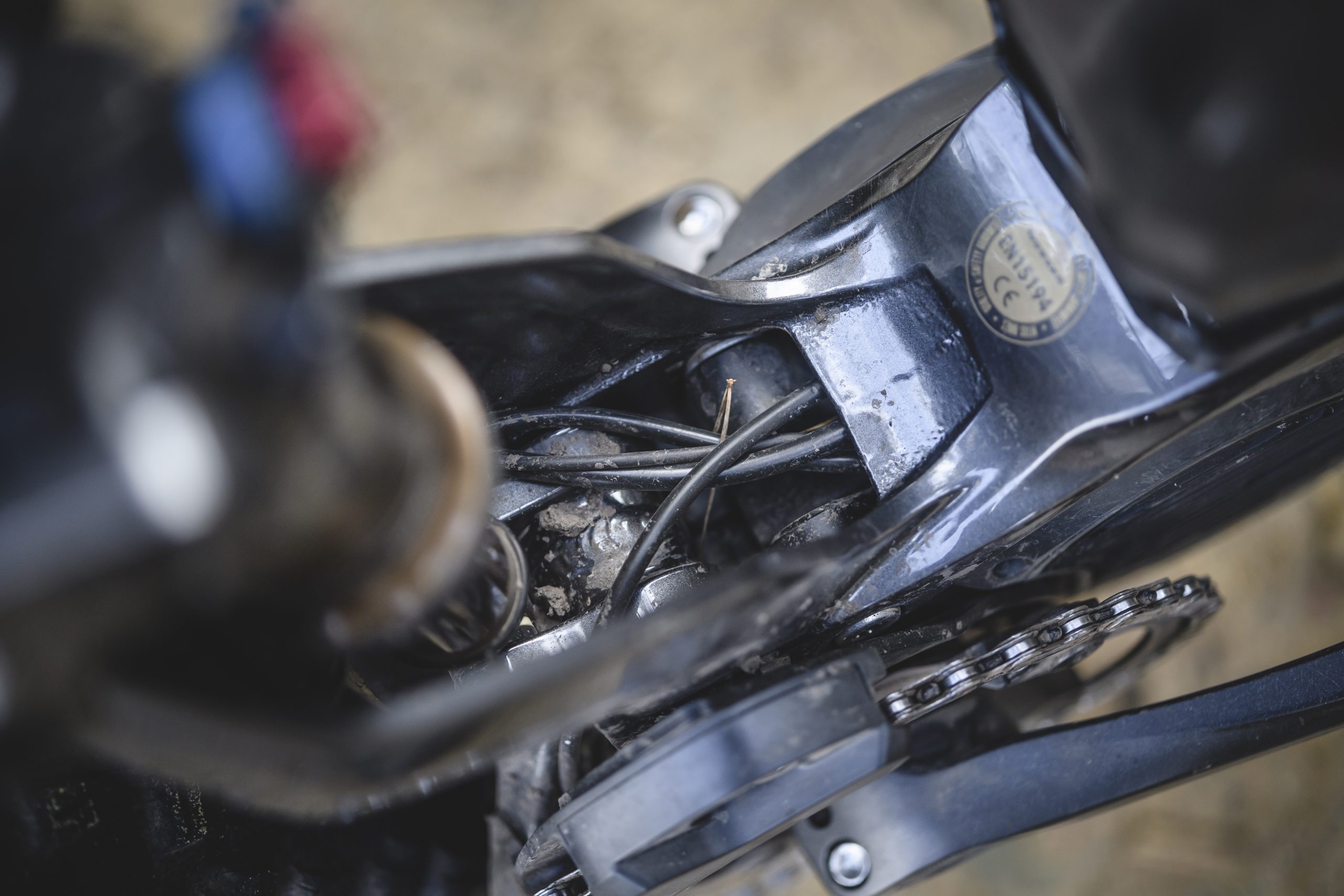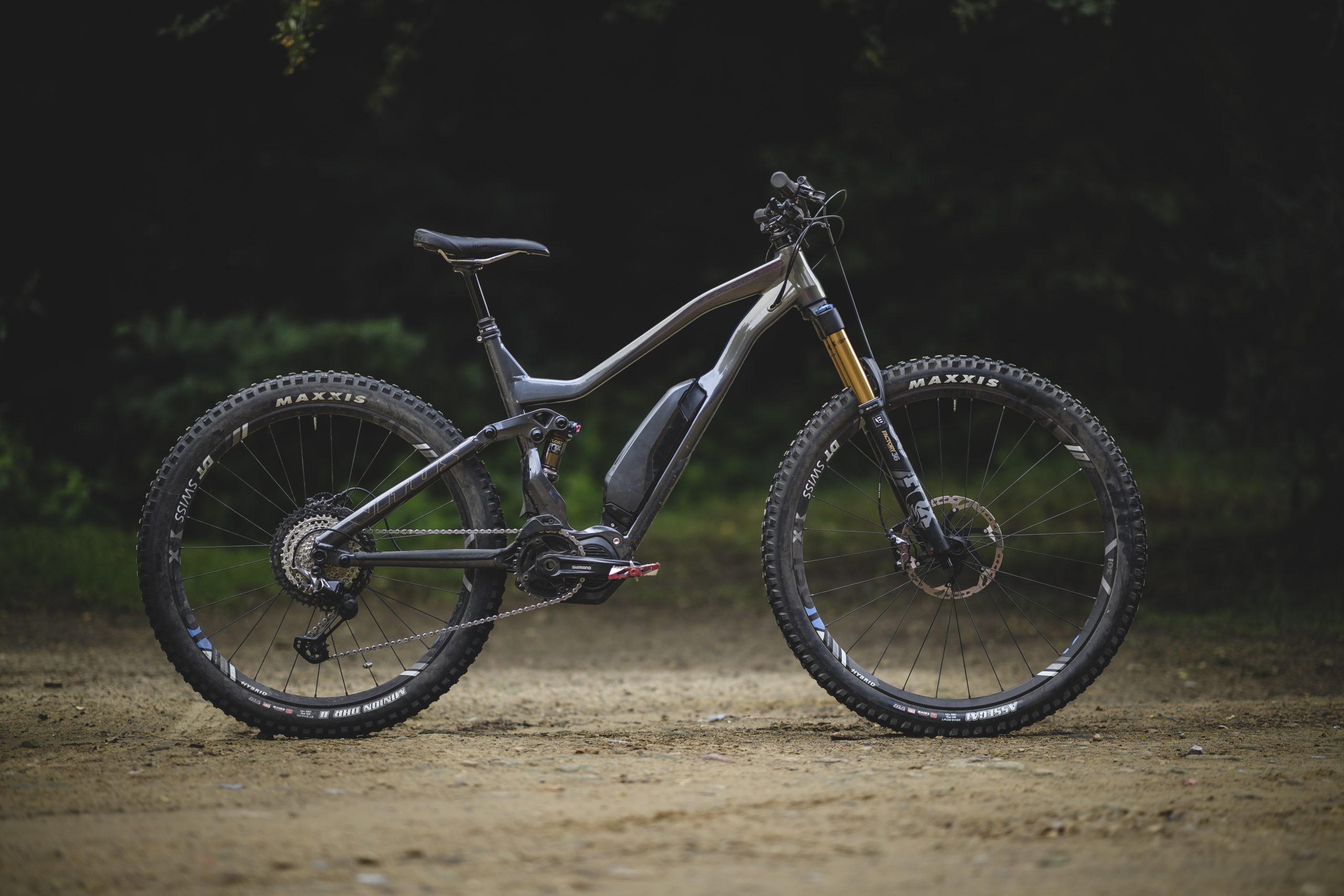The Vitus E-Sommet has won our annual e-bike test for a couple of years running now, and this is the new trail-orientated version, with slightly less travel and a mixed wheel sizes. It still boasts the same high-spec and impressive value-for-money as its enduro-rated sibling, but combines those assets into a more versatile package.
Vitus E-Escarpe VRX e-bike review
The Vitus E-Escarpe electric mountain bike doesn’t get a hidden battery or carbon frame, but it delivers an addictive ride at an impressive price.
>>> Best electric mountain bikes
Vitus E-Escarpe need to know
- Trail version of the test-winning E-Sommet
- 140mm travel front and rear with mullet wheels
- Shmano STEPS E8000 motor
- Top-of-the-range Fox Factory suspension and Shimano XTR parts
- Three bike range starts at £3,299

Shimano E8000 STEPS motor is a good unit but lacks a bit of punch and responsiveness compared to the latest Bosch Performance Line CX
At the heart of the Vitus E-Escarpe is a 6061 alloy frame with external battery and Shimano STEPS E8000 motor. It’s not the cleanest, sleekest design on the market, and the external battery might be unfashionable, but the configuration has its advantages and the alloy frame manages to compete on weight with the latest carbon models. In fact our E-Escarpe test bike was impressively light at 20.76kg in size large – some 1.3kg lighter than quoted. That compares favourably with the £10k Santa Cruz Heckler CC at 20.44kg, the YT Decoy Pro at 23.16kg and the Canyon Spectral:ON at 21.6kg. And that’s without resorting to fancy carbon wheels and other lightweight tricks (the Maxxis tyres get reinforced Exo+ sidewalls).

The cable routing doesn’t seem well resolved with the dropper post cable particularly badly positioned
Shimano’s 504Wh battery sits atop the down tube, and Vitus has made an effort to integrate it into the flow of the frame, so it doesn’t look like an afterthought. While it eliminates the possibility of mounting a bottle cage within the front triangle, removing the battery for charging indoors (or lifting into the back of a car) is extremely quick and easy. It’s not a high capacity battery by current standards (625Wh and 700Wh are fast becoming the norm at this price point) but the Shimano unit offers reasonable range (we got over 1,100m of climbing out of it in the dry in Trail mode with a 73kg rider) and spare units can be bought for around £500 if you want to ride further.
While the E8000 STEPS motor may not put out the same amount of power and torque as its German rivals (Bosch and Brose) it’s the slow speed of engagement and lack of overrun that makes the biggest dent in performance off-road. We’d like to see the motor respond more quickly if you have to stop pedalling briefly to hop up a root or step, and deliver a little boost of power to propel you over obstacles with your pedals level. These are aspects that Bosch has nailed with its new Performance Line CX software and they transform the way you ride. However, Shimano’s discreet control unit and display are masterpieces of design and give you all the information you need without dominating the cockpit.
Vitus has designed the E-Escarpe around 140mm of front and rear travel with a 29in wheel up front for better stability and bump rollover, paired with a 27.5 Plus wheel out back to inject some agility into the handling. Commonly known as a mullet configuration, it’s popular on e-bikes because it helps the bike tip into corners more readily, making it feel more maneuverable, while bringing a larger footprint to the rear tyre that gives additional traction on loose, steep or technical climbs. Vitus has made a sound spec decision here, by fitting DT Swiss’ e-bike specific HX1501 Spline wheels shod with reinforced Maxxis Assegai/Minion DHR II tyres. The wheels feature beefier construction both internally and externally to handle the additional weight and forces of an e-bike, while the Assegai tyre delivers grip by the shovel load up front in a wide range of conditions. It’s a relatively fast-rolling front tyre too, considering the grip levels, so range isn’t unduly compromised by extra drag. Out back the Minion DHR II paddles dig deep into soft loam for climbing traction and braking power, but the 2.8in width requires precise air pressure set-up to balance grip with stability. Too soft and the back end feels vague when cornering hard and loading the bike into berms and dips. Too hard and you lose the benefit of the extra footprint. At times it felt great, while at others it squirmed and scrubbed which robbed me of confidence. If you don’t like it, you could always downsize to a 2.6in tyre to bring more stability and a more normal ride feel.
Fox’s Factory-level 36 FIT Grip2 fork dominates the helm and with only 140mm travel to cope with, there’s plenty of bushing overlap and a really dependable, solid steering feel. It’s got lots of support, so you don’t blow through the travel on steep pitches with your weight over the front end, but the damping feels skewed towards heavier riders and it can feel a touch harsh on the palms over really rough washboard. For the money though, it’s a brilliant fork and highly tunable. Out back there’s a Fox Float DPS Factory shock. It might not have the extra oil volume of a piggyback, but I didn’t suffer with overheating and the tune was light enough that it delivered excellent grip with enough progression to handle big jumps and drops. Before I looked at the spec of this bike I assumed it was running 150mm or more travel, which just shows how effective it is on rough terrain. Equally, this light touch pays dividends on the climbs, where it generates extra grip as the pitch steepens or you have to negotiate roots and rocks.

The big footprint of the Plus tyre gives great traction for climbing but needs careful pressure set-up to prevent squirming under cornering loads
Shimano’s wide-range XT drivetrain is embellished by a fancy XTR rear derailleur. It shifts well and the gear range is great, but the shifter can swing across multiple gears at a time, which is the biggest contributor to drivetrain wear and chain breakages, so you have to remember to only change one ratio at a time. Shimano’s XT four-piston brakes have a ton of stopping power from the moment the pads touch the disc, and thankfully they were strong and consistent without the wandering bite point that has plagued some XT units.
I had few criticisms of the other components. The Nukeproof handlebars and stem are stiff with a good shape, the grips are thin but not too jarring and the WTB Volt Race 142 saddle is an old design that feels as fresh as the day it was released. Only the Brand X Ascend dropper post required a lot of force to activate the lever. Upgrading to a high-quality (Shimano) inner and outer cable would really help the action, but the cable routing also needs attention as it spirals around the shock in a tight radius that undoubtedly adds friction.
How it rides
More and more attention is being paid to ensuring e-bikes handle as well as their naturally-aspirated cousins. No longer is it enough to dominate the climbs and deliver rock-solid stability on the descents – they have to turn and jump just as willingly as regular bikes. The E-Escarpe nails this aspect and feels just as agile and fun to chuck into a corner as it does to deathgrip across some moto whoops. There’s plenty of stability low down in the frame, so you can really hammer it over braking bumps and big holes, but the centred weight and 27.5in rear wheel means it switches direction rapidly and intuitively and can be thrown into all sorts of shapes when the opportunity arises to leave the ground. You can’t help but ride faster and take liberties, yet the Vitus never backs away and leaves you with your pants down. It’s a trail bike in terms of travel, but an enduro bike in terms of attitude.
While I have zero complaints about the geometry, the tall seat tube does slightly inhibit your movements on the bike. It may not be possible owing to the interrupted seat tube design, but I’d love to see 20mm or so chopped off the seat tube height and added to the dropper post length.
Shimano’s E8000 motor may be getting old, but it works well in this application and at this price point. In direct comparison with the Bosch, it lacks the power and ultimate control, but it still works well and doesn’t detract from the E-Escarpe’s ride experience.

Verdict
I had an absolute blast riding the E-Escarpe, to the extent that I chose to ride it over several much more expensive e-bikes – with carbon frames and more travel – that were left hanging up in the workshop. It might not have the latest motor or the biggest battery, but it’s huge fun to ride with capable suspension and geometry and a great spec for the price. It’s proof that the motor is not the most important aspect of an e-bike, and the fundamentals of suspension tuning and handling through geometry will always underpin a good bike – whether it’s assisted or not.




















